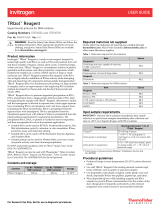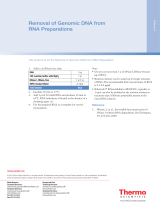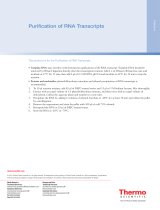Page is loading ...

TRIzol™ LS Reagent and Phasemaker™ Tubes Complete System
Catalog Numbers A33252 and A33253
Pub. No. MAN0016164 Rev. A.0
WARNING! Read the Safety Data Sheets (SDSs) and follow the
handling instructions. Wear appropriate protective eyewear,
clothing, and gloves. Safety Data Sheets (SDSs) are available
from thermosher.com/support.
Product information
Invitrogen™ TRIzol™ LS Reagent is a ready-to-use reagent, designed to
isolate high quality total RNA from cell and tissue samples of human,
animal, plant, yeast, or bacterial origin, within one hour. TRIzol™ LS
Reagent is a monophasic solution of phenol, guanidine isothiocyanate,
and other proprietary components which facilitate the isolation of a
variety of RNA species of large or small molecular size. TRIzol™ LS
Reagent maintains the integrity of the RNA due to highly eective
inhibition of RNase activity while disrupting cells and dissolving cell
components during sample homogenization. TRIzol™ LS Reagent
allows for simultaneous processing of a large number of samples, and
is an improvement to the single-step RNA isolation method developed
by Chomcynski and Sacchi (Chomczynski and Sacchi, 1987).
TRIzol™ LS Reagent allows to perform precipitation of RNA from a
single sample (Chomczynski, 1993). After homogenizing the sample
with TRIzol™ LS Reagent, chloroform is added, and the homogenate is
allowed to separate into a clear upper aqueous layer (containing
RNA), an interphase, and a red lower organic layer (containing the
DNA and proteins). Phasemaker™ Tubes facilitate the transfer of the
aqueous layer containing the RNA by creating a physical barrier
between the upper and lower phases. RNA is precipitated from the
aqueous layer with isopropanol. The precipitated RNA is washed to
remove impurities, and then resuspended for use in downstream
applications. Phasemaker™ Tubes are inert, heat stable, and do not
interfere with standard RNA applications.
Isolated RNA can be used in RT-PCR, Northern Blot analysis, Dot Blot
hybridization, poly(A)+ selection, in vitro translation, RNase
protection assay, and molecular cloning.
IMPORTANT! TRIzol™ LS Reagent is designed for processing liquid
samples (blood and virus preparations, for example). Do not use
TRIzol™ LS Reagent undiluted with solid samples. Processing solid
samples with TRIzol™ LS Reagent results in decreased yield.
Contents and storage
Contents Cat. No. A33252
(100 reactions)
Cat. No. A33253
(200 reactions) Storage
TRIzol™ LS
Reagent 100 mL 200 mL
15–30°C
Phasemaker™
Tubes 100 tubes 200 tubes
Required materials not supplied
Unless otherwise indicated, all materials are available through
thermosher.com. MLS: Fisher Scientic (sherscientic.com) or
other major laboratory supplier.
Item Source
Equipment
Centrifuge and rotor capable of reaching
12,000 ×
g
and 4°C MLS
Water bath or heat block at 55–60°C MLS
Tubes
Polypropylene microcentrifuge tubes MLS
Reagents
Chloroform MLS
Isopropanol MLS
Ethanol, 75% MLS
RNase-free water of 0.5% SDS MLS
(Optional)
RNase-free glycogen MLS
Input sample requirements
IMPORTANT! Perform RNA isolation immediately after sample
collection or quick-freeze samples immediately after collection and
store at –80°C or in liquid nitrogen until RNA isolation.
Sample type Starting material per 0.75 mL of
TRIzol™ LS Reagent
Biological fluids[1] 0.25 mL of biological sample
[1] Biological fluids with high levels of contamination material (whole blood, for
instance) should be diluted 1:1 with RNase-free water.
Procedural guidelines
• Perform all steps at room temperature (20–25°C) unless otherwise
noted.
• Use cold TRIzol™ LS Reagent if the starting material contains high
levels of RNase, such as spleen or pancreas samples.
• Use disposable, individually wrapped, sterile plastic ware and
sterile, disposable RNase-free pipees, pipee tips, and tubes.
• Wear disposable gloves while handling reagents and RNA
samples to prevent RNase contamination from the surface of the
skin; change gloves frequently, particularly as the protocol
progresses from crude extracts to more puried materials.
• Always use proper microbiological aseptic techniques when
working with RNA.
• Use RNaseZap™ RNase Decontamination Solution (Cat.
no. AM9780) to remove RNase contamination from work surfaces
and non-disposable items such as centrifuges and pipees used
during purication.
•Always maintain a ratio of 3:1 between the volume of TRIzol™ LS
Reagent and the sample.
• To facilitate isolation of RNA from small quantities of samples (
<106 cells or <10 mg of tissue) or for sample volumes <0.25 mL,
adjust the sample volume to 0.25 mL with RNase-free water.
USER GUIDE
For Research Use Only. Not for use in diagnostic procedures.

Isolate RNA
a. Centrifuge the Phasemaker™ Tubes for 30 seconds at 12,000–16,000 × g prior to use.
b. Add 0.75 mL of TRIzol™ LS Reagent per 0.25 mL of sample volume.
c. Homogenize the sample by pipeing up and down several times.
Note: The sample volume should not exceed 10% of the volume of TRIzol™ LS Reagent used for lysis. If
the ratio is higher, add 50– 100 µL of nuclease-free water to the lysate.
STOPPING POINT Samples can be stored at 4°C overnight or at –20°C for up to a year.
d. (Optional) If samples have a high fat content, centrifuge the lysate for 5 minutes at 12,000 × g at 4–10°C,
then transfer the clear supernatant to a new tube.
e. Transfer the samples (0.1–1.3 mL) to the Phasemaker™ Tubes .
f. Incubate for 5 minutes to permit complete dissociation of the nucleoproteins complex.
g. Add 0.2 mL of chloroform per 0.75 mL of TRIzol™ LS Reagent used for lysis, then securely cap the tube.
The total volume of the lysate cannot exceed 1.7 mL.
h. Shake vigorously by hand for 15 seconds.
i. Incubate for 2–15 minutes.
j. Centrifuge the sample for 5 minutes at 12,000–16,000 × g at 4°C.
The mixture separates into a lower red phenol-chloroform, and interphase, and a colorless upper
aqueous phase. The Phasemaker™ Gel forms a barrier between the upper and lower phases.
k. Transfer the aqueous phase containing the RNA to a new tube.
IMPORTANT! Avoid puncturing or touching the Phasemaker™ Gel with the pipee when removing the
aqueous phase.
1Lyse samples and separate
phases
a. Add 0.5 mL of isopropanol to the aqueous phase, per 0.75 mL of TRIzol™ LS Reagent used for lysis.
b. Incubate for 10 minutes.
c. Centrifuge for 10 minutes at 12,000 × g at 4°C.
Total RNA precipitate forms a white gel-like pellet at the boom of the tube.
d. Discard the supernatant with a micropipeor.
2Precipitate the RNA
a. Resuspend the pellet in 1 mL of 75% ethanol per 0.75 mL of TRIzol™ LS Reagent used for lysis.
Note: The RNA can be stored in 75% ethanol for at least 1 year at –20°C, or at least 1 week at 4°C.
b. Vortex the sample briey, then centrifuge for 5 minutes at 7500 × g at 4°C.
c. Discard the supernatant with a micropipeor.
d. Vacuum or air dry the RNA pellet for 5–10 minutes.
IMPORTANT! Do not dry the pellet by vacuum centrifuge. Do not let the RNA pellet dry, to ensure total
solubilization of the RNA. Partially dissolved RNA samples have an A230/280 ratio <1.6.
3Wash the RNA
a. Resuspend the pellet in 20–50 µL of RNase-free water, 0.1 mM EDTA, or 0.5% SDS solution by pipeing
up and down.
IMPORTANT! Do not dissolve the RNA in 0.5% SDS if the RNA is to be used in subsequent enzymatic
reactions.
b. Incubate in a water bath or heat block set at 55–60°C for 10–15 minutes.
Proceed to downstream applications, or store the RNA at –70°C.
4Solubilize the RNA
2
TRIzol
™
LS Reagent andPhasemaker
™
Tubes Complete System User Guide

Determine the RNA yield using one of the following methods.
Method Procedure
Absorbance
Absorbance at 260 nm provides total
nucleic acid content, while absorbance at
280 nm determines sample purity. Since
free nucleotides, RNA, ssDNA, and dsDNS
absorb at 260 nm, they all contribute to the
total absorbance of the sample.
1. Dilute sample in RNase-free water, then measure absorbance at
260 nm and 280 nm.
2. Calculate the RNA concentration using the formula A260 ×
dilution × 40 = µg RNA/mL.
3. Calculate the A260/A280 ratio.
A ratio of ~2 is considered pure.
RNA samples can be quantified by absorbance without prior dilution
using the NanoDrop™ Spectophotometer. Refer to the instrument's
instructions for more information.
Fluorescence
Fluorescence selectively measures intact
RNA, but does not measure protein or
other contaminant present in the sample
• Quantify RNA yield using the appropriate Qubit™ or Quant-iT™ RNA
Assay Kit (Cat. Nos. Q32852, Q10210, Q33140, or Q10213).
Refer to the kit's instructions for more information.
Table 1 Typical RNA (A260/280 of >1.8) yields from various starting materials
Starting material Quantity RNA yield
Human blood 250 µL 2.6–4.0 µg
1 mL 15–20 µg
Human leukocytes 7 × 107 cells 60–70 µg
7 × 108 cells 1109 µg
5Determine the RNA yield
Troubleshooting
Observation Possible cause Recommended action
A lower yield than expected is
observed
The samples were incompletely
homogenized or lysed.
Decrease the amount of starting material.
Cut tissue samples into smaller pieces and ensure the tissue is
completely immersed in TRIzol™ LS Reagent to achieve total lysis.
The pellet was incompletely
solubilized
Increase the solubilization rate by pipetting the sample repeatedly, and
heat the sample to 50–60°C.
The aqueous phase is incompletely
removed.
Phasemaker Gel sits at the interphase, therefore little DNA will be
present in the aqueous phase. Treat samples with DNase prior to any
downstream applications.
Make sure that all of the aqueous layer is transferred to a new tube.
The sample is degraded Samples were not immediately
processed or frozen after collection.
Sample must be processed or frozen immediately after collection.
Sample preparations were stored at
the incorrect temperature.
Store RNA samples at –60 to –70°C.
The RNA is contaminated The pipette tip came in contact with
the interphase/organic phase.
Phasemaker™ Gel sits at the interphase, therefore little DNA will be
present in the aqueous phase. Treat samples with DNase prior to any
downstream applications.
The Phasemaker tube containing the
lysate was centrifuged at room
temperature.
Centrifuge the Phasemaker™ tube containing the lysate at 4°C.
Higher temperatures increase the presence of DNA in the aqueous
phase.
The RNA A260/280 ratio is low Sample was homogenized in an
insufficient volume of TRIzol™ LS
Reagent.
Add the appropriate amount of TRIzol™ LS Reagent for your sample type.
Always maintain a ratio of 3:1 between the volume of TRIzol™ LS
Reagent and the sample.
Phasemaker™ Gel does not appear
uniform
The TRIzol™ LS Reagent to sample
ratio is less than 3:1.
If the barrier is intact, proceed with protocol. If there appears to be a
hole or space in the barrier, or the aqueous phase has colored hue,
retrieve the sample and place in a new Phasemaker™ tube. Add
chloroform and 50–100 µL of nuclease-free water, then proceed
according to protocol.
Limited product warranty
Life Technologies Corporation and/or its aliate(s) warrant their
products as set forth in the Life Technologies' General Terms and
Conditions of Sale found on Life Technologies' website at
www.thermosher.com/us/en/home/global/terms-and-
conditions.html. If you have any questions, please contact Life
Technologies at www.thermosher.com/support.
References
Chomczynski, P. 1993. A reagent for the single-step simultaneous isolation
of RNA, DNA and proteins from cell and tissue samples. BioTechniques 15,
532-537
Chomczynski, P., and Sacchi, N. 1987 Single Step Method of RNA
Isolation by Acid Guanidinium Thiocyanate-Phenol-Chloroform Extraction.
Anal. Biochem. 162, 156-159
TRIzol
™
LS Reagent andPhasemaker
™
Tubes Complete System User Guide
3

Hummon, A. B., Lim S. R., Dilippantonio, M. J., and Ried, T. 2007
Isolation and solubilization of proteins after TRIzol® extraction of RNA and
DNA from patient material following prolonged storage. BioTechniques 42,
467-472
The information in this guide is subject to change without notice.
DISCLAIMER: TO THE EXTENT ALLOWED BY LAW, LIFE TECHNOLOGIES AND/OR ITS AFFILIATE(S) WILL NOT BE LIABLE FOR SPECIAL, INCIDENTAL, INDIRECT, PUNITIVE,
MULTIPLE, OR CONSEQUENTIAL DAMAGES IN CONNECTION WITH OR ARISING FROM THIS DOCUMENT, INCLUDING YOUR USE OF IT.
Revision history: Pub. No. MAN0016164
Revision Date Description
A.0 09 November 2016 New document
Important Licensing Information: These products may be covered by one or more Limited Use Label Licenses. By use of these products, you accept the terms and conditions of all
applicable Limited Use Label Licenses.
Corporate entity: Life Technologies Corporation | Carlsbad, CA 92008 USA | Toll Free in USA 1 800 955 6288
©2016 Thermo Fisher Scientific Inc. All rights reserved. All trademarks are the property of Thermo Fisher Scientific and its subsidiaries unless otherwise specified.
For support visit thermofisher.com/support or email [email protected]
thermofisher.com
9 November 2016
/














